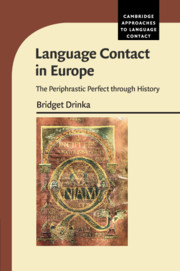Book contents
- Frontmatter
- Contents
- Series Editor's Foreword
- Acknowledgments
- Abbreviations, Based on the Leipzig Glossing Rules
- 1 Language Contact in Europe: The Periphrastic Perfect through History
- 2 Languages in Contact, Areal Linguistics, and the Perfect
- 3 The Perfect as a Category
- 4 Sources of the Perfect in Indo- European
- 5 The Periphrastic Perfect in Greek
- 6 The Periphrastic Perfect in Latin
- 7 The Charlemagne Sprachbund and the Periphrastic Perfects
- 8 The Core and Peripheral Features of the Romance Languages
- 9 The Early Development of the Perfect in the Germanic Languages
- 10 The Semantic Shift of Anterior to Preterite
- 11 The Balkan Perfects: Grammaticalization and Contact
- 12 Byzantium, Orthodoxy, and Old Church Slavonic
- 13 The l- perfect in North Slavic
- 14 Updating the Notion of Sprachbund: New Resultatives and the Circum- Baltic “Stratifi ed Convergence Zone”
- 15 The have Resultative in North Slavic and Baltic
- 16 Conclusions
- Notes
- Bibliography
- Index
16 - Conclusions
Published online by Cambridge University Press: 23 February 2017
- Frontmatter
- Contents
- Series Editor's Foreword
- Acknowledgments
- Abbreviations, Based on the Leipzig Glossing Rules
- 1 Language Contact in Europe: The Periphrastic Perfect through History
- 2 Languages in Contact, Areal Linguistics, and the Perfect
- 3 The Perfect as a Category
- 4 Sources of the Perfect in Indo- European
- 5 The Periphrastic Perfect in Greek
- 6 The Periphrastic Perfect in Latin
- 7 The Charlemagne Sprachbund and the Periphrastic Perfects
- 8 The Core and Peripheral Features of the Romance Languages
- 9 The Early Development of the Perfect in the Germanic Languages
- 10 The Semantic Shift of Anterior to Preterite
- 11 The Balkan Perfects: Grammaticalization and Contact
- 12 Byzantium, Orthodoxy, and Old Church Slavonic
- 13 The l- perfect in North Slavic
- 14 Updating the Notion of Sprachbund: New Resultatives and the Circum- Baltic “Stratifi ed Convergence Zone”
- 15 The have Resultative in North Slavic and Baltic
- 16 Conclusions
- Notes
- Bibliography
- Index
Summary
This chapter provides a synopsis of the major findings and arguments from each of the preceding chapters, followed by a discussion of the larger conclusions that can be drawn from these findings.
Chronological Summary
Following an introduction to the general premises in Chapter 1, evidence was presented in Chapter 2 that the notion of Sprachbund is appropriate for certain parts of Europe, such as the Balkans and parts of Western Europe, but that a more dynamic model is called for particularly in such areas as the Circum-Baltic area, where macro- and micro-contacts have produced multidimensional patterns of relationship among varieties. For this highly complex, stratified outcome, a more appropriate designation is proposed: a “Stratified Convergence Zone.” Details of this visualization are laid out in more detail in Chapter 14.
In Chapter 3, the validity of the concept of PERFECT as a universal category was assessed, and the hodological (‘path-oriented’) approach of Bybee, Perkins, and Pagliuca (1994) was examined in detail. While anteriority can be expressed in a fairly large number of languages worldwide, it was found that the semantic space that perfects occupy differs substantially from language to language. Thus, rather than viewing the perfect as a unified, universal category, we should instead regard the related semantic features of CURRENT RELEVANCE, RESULTATIVE, COMPLETIVE, PERFECTIVE, INFERENTIAL PAST, and so on, as concepts available for incorporation into morphosyntactic categories, according to the cognitive and social pressures experienced by speakers. The HAVE perfect turns out to be extremely rare in the languages of the world, and has been identified as a “quirk” of Western Europe (Cysouw 2011), and in no way representative of a universal category.
In Chapter 4, the chronological account of the development of the periphrastic perfects was initiated with an examination of the features of the category and related structures that date back to Proto-Indo-European: synthetic verbal categories like the reduplicated perfect and aorist, and the components of periphrastic structures such as the BE copula and verbal adjectives and participles in *-wos-/-us-, *-l-, and *-to-/-no-. The multifaceted nature of the widely distributed *–to-/-no- participle may indicate that some periphrasis had already developed in the proto-language. Its flexible semantic value clearly played a decisive role in determining the direction that the periphrastic replacements would take.
- Type
- Chapter
- Information
- Language Contact in EuropeThe Periphrastic Perfect through History, pp. 395 - 408Publisher: Cambridge University PressPrint publication year: 2017

